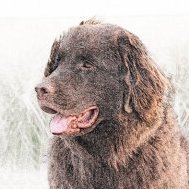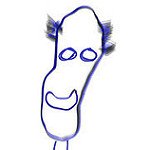-
Posts
1,309 -
Joined
-
Last visited
Reputation Activity
-
 smadell reacted to kat in Can you import gradient maps?
smadell reacted to kat in Can you import gradient maps?
I redid the gold gradient map. here it isgold grad map.afphoto
-
 smadell reacted to kat in Can you import gradient maps?
smadell reacted to kat in Can you import gradient maps?
Now that I finally noticed "Add Preset" I'll remake my gold. Thanks @smadell You're a star!
-
 smadell got a reaction from kat in Can you import gradient maps?
smadell got a reaction from kat in Can you import gradient maps?
Good morning, @kat. Regarding the import of gradient maps, I simply don’t think there’s any way to do this. For some reason, Serif decided that gradients and gradient maps are so completely different that can’t share a file type. I have always maintained that there should be a centralized repository for gradients (in a manner similar to Photoshop's) which can be accessed to form linear, radial, and other types of gradients, but can also be used as the basis for creating gradient maps (even if the user edits the position, opacity, etc of the various color stops). Alas, this is not (yet?) the case. Since there is no file type extension for an Affinity Photo gradient map, they cannot be easily exported and/or imported.
The only way I know of to share them is to create a document using multiple gradient map adjustment levels and share that document. Then, the recipient can open the document, turn on each individual gradient map adjustment, and save it as a preset. Clunky, to be sure.
A gradient map’s settings can also be stored in a macro, but that’s even more difficult if the primary purpose is simply to share settings.
I’ve attached an .afphoto document for you with all of the “cool gradient maps” you asked about earlier. If you want to keep all or some of them, open the adjustment layer and click “Save as Preset” in the panel. I’ve also included a link to a macro I posted a while back for enhancing skin tones, which you might want to try out.
Gradient Map Transfer.afphoto
-
 smadell got a reaction from kat in Enhance Skin Tones - FREE Macros for Download
smadell got a reaction from kat in Enhance Skin Tones - FREE Macros for Download
I hope these work for you, @James19. Enjoy them, and please come back and comment (or post a before & after) when you've had some time to use them!
-
 smadell got a reaction from kat in Enhance Skin Tones - FREE Macros for Download
smadell got a reaction from kat in Enhance Skin Tones - FREE Macros for Download
The examples above may just be too subtle. Here's' another photo with Original and Enhanced Skin Tones versions. The results may be a bit more obvious.
-
 smadell got a reaction from kat in Enhance Skin Tones - FREE Macros for Download
smadell got a reaction from kat in Enhance Skin Tones - FREE Macros for Download
I have attached a macro category called "Enhance Skin Tones." This is a free download which will help add color and tone to the skin of your portraits. There are 21 different enhancement macros included, grouped for Light, Peach, Tan, and Dark skin. These macros are meant to enhance, not replace, skin colors. The macros are all based on the use of Gradient Maps, and use different dark and light colors along with setting opacity and blend mode for each adjustment.
While the skin tone macros are grouped into Light, Peach, Tan, and Dark skin groups (roughly corresponding to Caucasian, Asian, Hispanic, and African coloration) they are certainly not exclusive. You may want to experiment using the adjustments from any (or all) of the groups to add different coloration and tone to your underlying portrait.
The Light and Peach skin tone macros add a gradient map and set its opacity to 25%. The Tan skin tone macros set the opacity to 30%. The Dark skin tone macros set the opacity to 40%. All of the macros set the blend mode of the gradient map adjustment to Soft Light. You should also experiment with changing the opacity and blend mode of the adjustments, as these will create different effects that you might like. Try using blend modes such as Overlay, Linear Light, and even Multiply. The results can be subtle, but changing the default settings can often make them fairly dramatic.
An important note: the macros work best when you have the skin selected prior to invoking the macros. This ensures that the gradient map adjustment uses your selection as a mask, and applies the changes to the skin only. As with all layer masks, however, you can edit the mask (by painting on the adjustment layer in black or white) after the fact.
Here is a graphic that includes 4 portraits (labelled as Original versions) along with versions of each of the 21 different skin tone enhancing macros. The enhanced versions are all based on the default settings for the respective macros. Under each example is the name of the skin tone macro used, along with a gradient representing the dark and light colors used in the gradient map adjustment. Remember that these results look very subtle, but your results can be more dramatic simply by increasing the opacity slider.
The attached macro category was created in Affinity Photo 2, and probably will not be compatible with version 1. It is a category and therefore should be imported into the Library panel (using the "hamburger menu" at the panel's top right corner). The category includes the 21 skin tone macros, but also includes a macro called "Try All Skin Tones" which will create a group (with sub-groups) that includes all 21 adjustments so you can try them all to see which one you like. There is also a macro called "Instructions - Enhance Skin Tones" which will display on-screen instructions for using the macros. These instructions are placed in a separate layer which you should delete after having read and understood the instructions.
[These macros are loosely based on some of the gradients used in a recent YouTube video by Blake Rudis, whose f64 Academy channel has been quite helpful (especially for matters concerning color grading). Blake's videos are exclusively aimed at Photoshop users, but the methods he uses are almost always compatible with similar methods in Affinity Photo. So, a big thank-you to him.]
As with all of my Resource uploads, these are the work of 1 person working on 1 computer. I do not pretend to have tested them extensively, but I believe they will function as they are supposed to. Try them and see if they work for you. If they do, they are free for your use without restriction.
I have always encouraged users to "pay it forward" and help others in this forum as they themselves become more knowledgeable and adept at using Affinity Photo. This is how knowledge and good will spreads.
Enhance Skin Tones.afmacros
-
 smadell got a reaction from kat in Can you import gradient maps?
smadell got a reaction from kat in Can you import gradient maps?
@kat - You got me hooked. Never one to shy away from a challenge (or so I claim…) I watched the video. Obviously, Clip Studio Paint is wholly different from Affinity Photo, but I think that what I came up with is essentially the same process. I've attached a video, but basically I (i) masked out the area I wanted to paint; (ii) added a Pixel layer in which I added shading in black and white; and (iii) added a Gradient Map above that shading layer. Since the Gradient Map will apply different colors depending on the luminosity of the underlying layer, I can change the color by lightening or darkening the Shading layer. Effectively, it's dodging and burning with the goal of changing the luminosity so that the gradient map applies different colors.
A picture is worth a thousand words, so a video is probably even better. Try this:
Gradient Map Painting.mp4
-
 smadell got a reaction from Alfred in Can you import gradient maps?
smadell got a reaction from Alfred in Can you import gradient maps?
@kat - If that’s what you’re after, then have I got a solution for you! Seriously, I saw the same YouTube video a while back, and posted a macro to create the same effect. You can download it (along with an explanatory PDF) here:
-
 smadell got a reaction from kat in Can you import gradient maps?
smadell got a reaction from kat in Can you import gradient maps?
@kat - If that’s what you’re after, then have I got a solution for you! Seriously, I saw the same YouTube video a while back, and posted a macro to create the same effect. You can download it (along with an explanatory PDF) here:
-
 smadell got a reaction from kat in Reticulated Gradient Map - a FREE Macro Download
smadell got a reaction from kat in Reticulated Gradient Map - a FREE Macro Download
I am attaching a macro category called “Reticulated Gradient Map” which can be used for color grading or for creating an artistic rendition of a photograph. The look was inspired by a recently viewed YouTube video on the Texturelabs channel in which an image was posterized and gradient mapped, but with a specific type of grain applied to the borders of the colors. The original video can be found here.
The effect relied on a filter found in Photoshop’s Filter Gallery called “Reticulation”. Although the Reticulation filter is not available in Affinity Photo, this macro duplicates the effect fairly reliably.
Here is a before and after image, along with the User Dialog settings used during the image’s creation.
The macro creates a number of adjustments and other layers inside a Group called Reticulated Color Grade. Because the effect is entirely contained inside the group, the effect can be turned on and off by showing/hiding the enclosing group. Also, the effect is entirely non-destructive (with one exception, discussed below) and will respond immediately to any additional edits made to the original image.
I have also created a PDF (also attached to this post) with specific instructions for using this macro. However, in brief, invoking the macro will set up the Layers stack (as above) and present a dialog to the user for some initial settings. You will be asked to set the following:
1) Adjust Reticular Noise Size (destructive)
The “Reticulation Noise” layer is a pixel layer in which a reticulated pattern of noise is applied. The macro invokes an “Equations” filter to increase or decrease the size of the noise. The default value is 0.8, and the slider will accept values between 0 and 1 (although anything above 0.8 is capped at that value, since the math falls apart above that value). In general, the default setting results in the largest reticular noise available, but the noise can be decreased in size by setting the slider to smaller values.
2) Adjust Reticular Noise Opacity
This slider affects the opacity of the “Reticulation Noise” layer. The overall effect is that, at lower values, the graininess of the reticulation is held closer and closer to the borders between colors. The default value is 20% and the slider will accept values between 0% and 100%. In general, keeping the value to smaller numbers is usually going to be more visually pleasing.
3) Distribute Tones
This slider affects the Gamma slider in a Levels adjustment. Because the Levels adjustment is applied prior to the Gradient Map, shifting the slider to the left or the right will shift the colors toward the lighter or darker tones respectively. Play with this a bit, watching for the appearance or disappearance of colors mapped to whites and blacks.
* * * * * * * * * * * * * * * * * * * * * *
The first setting, in which the “size” of the noise is adjusted, is a destructive change. It cannot be edited once the macro has been finalized. This particular slider should be set carefully. However, other values can be edited afterward. I would suggest the following edits after the macro has been allowed to complete.
1) Open the Distribute Tones layer. This is a Levels adjustment, and sits inside of the “Monochrome Group.” I have found it to be helpful to move the Black Level and White Level sliders inward so as to meet the left and right borders of the histogram. Also, you can adjust the Gamma slider so as to shift the gradient mapped colors toward the lighter and darker values.
2) Select the Reticulation Noise layer and fine tune the Opacity of that layer. You will find that adjusting the opacity of the layer will shift how much the graininess of the reticulation involves the individual colors. In general, keeping the Opacity low will keep the reticulation noise closer to the borders between the individual colors.
3) The macro uses a Gradient Map that uses purple and orange colors for its default. Obviously, you can change this (and you probably will want to!) Open the Gradient Map Adjustment layer and change the colors as you’d like. Using an adjustment preset will make this easier, but those presets are up to you. Be aware that the macro sets the Posterize adjustment to 5 levels, and the Gradient Map has stops at 0, 25, 50, 75, and 100%. This means that the end result will give 5 posterized colors, as represented by the colors chosen for those stops.
* * * * * * * * * * * * * * * * * * * * * *
The attached macro category should be imported into the Library panel, using the “hamburger menu” at the top right corner of the panel. The macro was created in Affinity Photo 2, and will not be compatible with version 1. Also, once the macro category is imported, you can drag the macro to any other category you already have set up. (I have placed the macro inside a Category that I created called “Color Grading” but you can set up your categories as you would like.)
* * * * * * * * * * * * * * * * * * * * * *
As with all of the macros that I have submitted please remember that I am one person working with one computer. I have tested the macro in a fairly limited fashion, and it works well for me. I believe that the macro functions as stated, but of course I cannot make any guarantees.
On the other hand, if you like the macro you should keep it and enjoy it. It is free to use for personal and/or commercial work, and you do not need to credit me in any way. My only requests are these: (i) please post a response in this Forum topic to let me know that you are using the macro and (hopefully) enjoying it; and (ii) please remember to “pay it forward” by contributing to the forum in any way you can. It is by sharing your experience and your expertise that we all improve our skills and our enjoyment.
Reticulated Gradient Map.afmacros Using the Reticulated Gradient Map Macro.pdf
-
 smadell got a reaction from kat in Can you import gradient maps?
smadell got a reaction from kat in Can you import gradient maps?
1) Download and save the .grd file
2) Open in your browser: https://mikestimpson.com/GrdToAfpalette/
3) Find the .grd file and convert it to an .afpalette file. Save this file to disk.
4) Import the .afpalette file into the Swatches panel
Technically you’ve created a palette full of gradients, not gradient maps. But you could create gradient maps from these, using the various gradient stops for your gradient map. Personally, I would love to see Serif revamp the way it handles gradients entirely, including the glaring omission of the ability to create a gradient map from an existing gradient. But, for now, this is the only way I know of.
-
 smadell got a reaction from Alfred in Can you import gradient maps?
smadell got a reaction from Alfred in Can you import gradient maps?
1) Download and save the .grd file
2) Open in your browser: https://mikestimpson.com/GrdToAfpalette/
3) Find the .grd file and convert it to an .afpalette file. Save this file to disk.
4) Import the .afpalette file into the Swatches panel
Technically you’ve created a palette full of gradients, not gradient maps. But you could create gradient maps from these, using the various gradient stops for your gradient map. Personally, I would love to see Serif revamp the way it handles gradients entirely, including the glaring omission of the ability to create a gradient map from an existing gradient. But, for now, this is the only way I know of.
-
 smadell reacted to Ldina in Too quiet …
smadell reacted to Ldina in Too quiet …
Only time will tell, right? There's a whole lot of speculation, (some probably fairly accurate, much probably way off the mark, but who's right?), and it seems a bit premature to announce "game over". Canva had their reasons for buying Serif, but I'm not privy to their reasons or plans. They paid too much money just to let it die...that would be stupid (which they aren't) and doesn't make much sense to me. People don't like 'not knowing', so imaginations tend to run wild.
I'm concerned and want to see Affinity improve and succeed, but I can't predict what's coming. If the Affinity Suite is working well and doing what you need it to do at the present time, keep using it...you already bought it (and aren't paying a monthly subscription). If it's not working for you, that's a different story. Corporate buyouts (I've been through many) are disruptive, reset goals and priorities, eat up staff resources during integrating, and it takes time for things to normalize. Been there, done that! Who knows what they're working on? I don't. Maybe they have something big coming that they want or need to keep quiet. It could be really great, more of the same, or pathetic. Not knowing makes people edgy, myself included, but I'll keep using it as long as it meets my needs. Why not? Beats an expensive Adobe subscription (at least for me).
So, I try to avoid gloom and doom or unrealistic expectations, and adopt a middle of the road wait and see attitude. Time will tell.
-
 smadell got a reaction from PaulEC in Too quiet …
smadell got a reaction from PaulEC in Too quiet …
Software roadmaps are tenuous things. Features, improvements, new applications - all these can be promised with the best of intentions, only to fall prey to the ill winds of fate and circumstances out of everyone’s control. That having been said, Affinity issued the most important roadmap of all back in March 2024:
1) Perpetual licenses will always be offered…
2) Affinity is here to stay.
Honestly, guys, everything else is icing on the cake.
-
 smadell got a reaction from Alfred in Frequency Separation
smadell got a reaction from Alfred in Frequency Separation
To use Frequency Separation, you must have a pixel layer selected in the Layers panel. In practical terms, I usually choose “Merge Visible” to create a new pixel layer that encapsulates all the editing I’ve done up to that point. Then, with the “merge visible” layer selected, I choose Frequency Separation… from the Filters menu. Once you set the proper radius in the dialog that opens, you will have a High Frequency and a Low Frequency layer. The High Frequency layer is already set to Linear Light blend mode. And, your “merge visible” layer is no longer there - it has been replaced by the Freq Sep layers.
-
 smadell got a reaction from Alfred in Trouble with using a mask
smadell got a reaction from Alfred in Trouble with using a mask
Are you using a Pixel layer as a mask? In other words, did you drag a “New Layer” into the masking position? If so, that would explain what’s happening. Using a pixel layer is fine, but the rules change a bit. Instead of “white reveals, black conceals,” the rule for pixel layers is that “painting reveals, erasing conceals.” Put plainly, anywhere there’s a pixel painted your image will be shown. Conversely, erasing those pixels will hide the image in that area.
-
 smadell got a reaction from PaoloT in Too quiet …
smadell got a reaction from PaoloT in Too quiet …
Software roadmaps are tenuous things. Features, improvements, new applications - all these can be promised with the best of intentions, only to fall prey to the ill winds of fate and circumstances out of everyone’s control. That having been said, Affinity issued the most important roadmap of all back in March 2024:
1) Perpetual licenses will always be offered…
2) Affinity is here to stay.
Honestly, guys, everything else is icing on the cake.
-
 smadell got a reaction from Alfred in Too quiet …
smadell got a reaction from Alfred in Too quiet …
Software roadmaps are tenuous things. Features, improvements, new applications - all these can be promised with the best of intentions, only to fall prey to the ill winds of fate and circumstances out of everyone’s control. That having been said, Affinity issued the most important roadmap of all back in March 2024:
1) Perpetual licenses will always be offered…
2) Affinity is here to stay.
Honestly, guys, everything else is icing on the cake.
-
 smadell got a reaction from j3rry in Too quiet …
smadell got a reaction from j3rry in Too quiet …
Software roadmaps are tenuous things. Features, improvements, new applications - all these can be promised with the best of intentions, only to fall prey to the ill winds of fate and circumstances out of everyone’s control. That having been said, Affinity issued the most important roadmap of all back in March 2024:
1) Perpetual licenses will always be offered…
2) Affinity is here to stay.
Honestly, guys, everything else is icing on the cake.
-
 smadell got a reaction from Ali in Too quiet …
smadell got a reaction from Ali in Too quiet …
Software roadmaps are tenuous things. Features, improvements, new applications - all these can be promised with the best of intentions, only to fall prey to the ill winds of fate and circumstances out of everyone’s control. That having been said, Affinity issued the most important roadmap of all back in March 2024:
1) Perpetual licenses will always be offered…
2) Affinity is here to stay.
Honestly, guys, everything else is icing on the cake.
-
 smadell got a reaction from thomaso in Trying to Reduce Shine on Face by using Pixel Layer not working ?
smadell got a reaction from thomaso in Trying to Reduce Shine on Face by using Pixel Layer not working ?
Hi, @augustya. Try watching this YouTube video by Blake Rudis from f64 Academy. It sounds like it addresses exactly what you’re describing.
-
 smadell got a reaction from cheeseslope in Trying to Reduce Shine on Face by using Pixel Layer not working ?
smadell got a reaction from cheeseslope in Trying to Reduce Shine on Face by using Pixel Layer not working ?
Hi, @augustya. Try watching this YouTube video by Blake Rudis from f64 Academy. It sounds like it addresses exactly what you’re describing.
-
 smadell got a reaction from Old Bruce in Unable to create a macro as required functions are not available.
smadell got a reaction from Old Bruce in Unable to create a macro as required functions are not available.
One other thing, @twosheds - if you find yourself “inside” a Group while recording a macro and want to select a layer that is outside of the Group, you cannot select the outer layer directly. You must first select the Group itself (you’ll be asked if you want to select the Parent, to which you should say Yes). Then, you can select the second layer. In essence, once inside a Group (or a layer that is a child of another layer) you must first “escape” the group before doing anything further outside of that group.
-
 smadell got a reaction from Raff in Affinity Photo - Lights and Shadows function
smadell got a reaction from Raff in Affinity Photo - Lights and Shadows function
I do not hate Affinity Photo (quite the contrary!) But I don't use the Develop persona. I don't use it primarily because it is terrible at dealing with shadows and highlights. It makes them a muddy mess. I am not a professional by any means, and I am not an Affinity basher. For the most part, I love this software. But I use Capture One for my raw development, and the video below will show you why.
A few caveats. (1) Since I don't use the Develop persona, I have never gotten very good at it. My attempts are probably not as good as they would be if I used that persona more often. (2) While there are numerous ways to tinker with shadows and highlights, my feeling is that if I shoot raw I should be able to recover shadows and highlights in the raw file, where they are most appropriately dealt with. (3) Workarounds aside, recovering shadows and highlights in AP is needlessly clunky.
As shown below, what I could barely accomplish in Affinity Photo I was able to do in Capture One in a matter of seconds. If Serif needs to think about where to allocate time, effort, and money, this would be a good place to start.
Raw Comparison.mp4
-
 smadell got a reaction from Ldina in Kudzu & Pine (InfraRed Photo)
smadell got a reaction from Ldina in Kudzu & Pine (InfraRed Photo)
My vote is for the original (infrared) version. Isn’t the rule ‘black and white if the color adds nothing or is distracting’? I think the original’s color (which is actually fairly minimal) adds to the interest!
PS: nice photo, by the way!




.thumb.jpg.2ac1b0424a6896c349d3d16eea40c7f3.jpg)






